An Integrated Approach of Belief Rule Base and Deep Learning to Predict Air Pollution
Abstract
:1. Introduction
- (1)
- What is the benefit of applying BRBES to compute air pollution prediction?Better performance of BRBES than other knowledge-driven approaches in terms of dealing with uncertainties is the key benefit of applying BRBES over sensor data of air pollutants.
- (2)
- What is the usefulness of adopting Deep Learning for air pollution prediction?Predicting pollution level based on the discovered hidden pattern of sensor data is the advantage of adopting Deep Learning architecture.
- (3)
- Why and how to combine Deep Learning with BRBES?Improving accuracy of the prediction is the justification for integrating Deep Learning with BRBES.
2. Related Works
3. Integrated Approach of BRB and Deep Learning
3.1. Rationale of Integration
3.2. Neural Network Representation
Mild Pollution = 0.3836/((0.9620 + 0.3836 + 0.00) = 0.29
Nominal Pollution = 0.00/((0.9620 + 0.3836 + 0.00) = 0.00
| Algorithm 1: an algorithm to achieve image based prediction of PM2.5 |
| Input: SP denotes the normalized probability that the image belongs to Severe Pollution class; MP denotes the normalized probability of Mild Pollution class, and NP denotes the normalized probability of Nominal Pollution class. |
| Output: PM2.5 concentrations predicted from the image (PM_Image). |
| Begin |
| 1 if ((SP > MP) and (SP > NP)) then |
| 2 PM_Image = (150.5 + 275.9* SP) + (150.4 * MP)/2 |
| 3 else if ((NP > SP) and (NP > MP)) then |
| 4 PM_Image = (35.4 * (1 – NP)) + ((150.4 * MP)/2) |
| 5 else if ((MP > SP) and (MP > NP)) then |
| 6 if (SP > NP) then |
| 7 PM_Image = (35.5 + 114.9 * MP) + ((500.4 * SP)/2) |
| 8 else if (NP > SP) then |
| 9 PM_Image = (35.5 + 114.9 * MP) + ((35.4 * NP)/2) |
| 10 return PM_Image |
| End |
| Algorithm 2: an algorithm to recalculate PM2.5 in a foggy weather |
| Input: T denotes the daily mean dry-bulb temperature (in degree celsius); RH denotes the instant relative humidity (between 0 and 1); IT denotes the instant on-site temperature (in degree celsius), and PM_CNN denotes the PM2.5 concentrations predicted by CNN in Algorithm 1. |
| Output: PM2.5 concentration in case the weather is foggy (PM_Image). |
| Begin |
| 1 if ((PM_CNN) >= 55.50) |
| 2 DT = T – ((100-RH)/5) |
| 3 if ((IT- DT) < 2.5) |
| 4 PO = (PM_CNN)/500.4 |
| 5 PM_Image = 55.40 * PO |
| 6 return PM_Image |
| End |
3.3. Integration of CNN with BRBES
3.3.1. Domain Knowledge Representation

3.3.2. BRBES Reasoning System
Input Transformation
- Low_Sensor, L1 = (150.5 − 35)/(150.5 − 0) = 0.77;
- Medium_Sensor, M1 = (1 − 0.77) = 0.23 and
- High_Sensor, H1 = (1 − 0.77 − 0.23) = 0.
- Low_CNN, L2 = (150.5 − 20.92)/(150.5 − 0) = 0.86;
- Medium_CNN, M2 = (1 − 0.86) = 0.14 and
- High_CNN, H2 = (1 − 0.86 − 0.14) = 0.0
Rule Activation Weight Calculation
Belief Degree Update
Rules Aggregation
| Algorithm 3: an algorithm to calculate single numerical crisp value of AQI |
| Input: H denotes the belief degree of the referential value ‘Hazardous’ of the consequent attribute ‘AQI’; U denotes the belief degree of ‘Unhealthy’ referential value, and G denotes the belief degree of ‘Good’ referential value of the consequent attribute. |
| Output: The crisp value of AQI (Q). |
| Begin |
| 1 if ((H > U) and (H > G)) then |
| 2 Q = (201 + 299*H) + ((200*U)/2) |
| 3 else if ((G > H) and (G > U)) then |
| 4 Q = (100*(1 − G)) + ((200*U)/2) |
| 5 else if ((U > H) and (U > G)) then |
| 6 if (H > G) then |
| 7 Q = (101 + 99*U) + ((500*H)/2) |
| 8 else if (G > H) then |
| 9 Q = (101 + 99*U) + ((100*G)/2) |
| 10 return Q |
| End |
3.3.3. Disjunctive BRBES
3.3.4. Joint Optimization of BRBES
3.4. Distributed Categorization of AQI
- Belief Degree for ‘Good’ category, ÿi1 = (Good) * (1 − rc)
- Belief Degree for ‘Moderate’ category, ÿi2 = (Good) * rc
- Belief Degree for ‘Unhealthy for sensitive groups’ category, ÿi3 = (Unhealthy) * (1 − rc)
- Belief Degree for ‘Unhealthy’ category, ÿi4 = (Unhealthy) * rc
- Belief Degree for ‘Very Unhealthy’ category, ÿi5 = (Hazardous) * (1 − rc)
- Belief Degree for ‘Hazardous’ category, ÿi6 = (Hazardous) * rc
- Belief Degree for ‘Good’ category, ÿi1 = (0.9098) * (1 − 0.3682) = 0.58
- Belief Degree for ‘Moderate’ category, ÿi2 = (0.9098) * 0.3682 = 0.33
- Belief Degree for ‘Unhealthy for sensitive groups’ category, ÿi3 = (0.0902) * (1 − 0.3682) = 0.06
- Belief Degree for ‘Unhealthy’ category, ÿi4 = (0. 0902) * 0.3682 = 0.03
- Belief Degree for ‘Very Unhealthy’ category, ÿi5 = (0.0) * (1 − 0.3682) = 0
- Belief Degree for ‘Hazardous’ category, ÿi6 = (0.0) * 0.3682 = 0
| Algorithm 4: an algorithm to calculate regression coefficient based on predicted AQI crisp value |
| Input: Q denotes the predicted crisp value of AQI. |
| Output: The regression coefficient (rc). |
| Begin |
| 1 if (Q >= 301) then |
| 2 rc = (Q - 301)/199 |
| 3 else if ((Q >= 201) and (Q <= 300)) then |
| 4 rc = (Q - 201)/99 |
| 5 else if ((Q >= 151) and (Q <= 200)) then |
| 6 rc = (Q - 151)/49 |
| 7 else if ((Q >= 101) and (Q <= 150)) then |
| 8 rc = (Q - 101)/49 |
| 9 else if ((Q >= 51) and (Q <= 100)) then |
| 10 rc = (Q - 51)/49 |
| 11 else if (Q <= 50) then |
| 12 rc = Q /49 |
| 13 return rc |
| End |
4. Experiments
4.1. Dataset
4.1.1. Synthetic Image Dataset
4.1.2. Shanghai City Dataset
4.2. Results
4.3. Discussion
5. Conclusions
Author Contributions
Funding
Acknowledgments
Conflicts of Interest
References
- Bustamante, A.L.; Patricio, M.A.; Molina, J.M. Thinger.io: An Open Source Platform for Deploying Data Fusion Applications in IoT Environments. Sensors 2019, 19, 1044. [Google Scholar] [CrossRef] [PubMed] [Green Version]
- Cui, L.; Zhang, Z.; Gao, N.; Meng, Z.; Li, Z. Radio Frequency Identification and Sensing Techniques and Their Applications-A Review of the State-of-the-Art. Sensors 2019, 19, 4012. [Google Scholar] [CrossRef] [PubMed] [Green Version]
- Peng, Y.; Wang, J.; Tan, A.; Wu, J. A Novel Resource Allocation and Spectrum Defragmentation Mechanism for IoT-Based Big Data in Smart Cities. Sensors 2019, 19, 3443. [Google Scholar] [CrossRef] [PubMed] [Green Version]
- Kenda, K.; Kazic, B.; Novak, E.; Mladenic, D. Streaming Data Fusion for the Internet of Things. Sensors 2019, 19, 1955. [Google Scholar] [CrossRef] [PubMed] [Green Version]
- Toma, C.; Alexandru, A.; Popa, M.; Zamfiroiu, A. IoT Solution for Smart Cities’ Pollution Monitoring and the Security Challenges. Sensors 2019, 19, 3401. [Google Scholar] [CrossRef] [PubMed] [Green Version]
- Di Nicolantonio, W.; Cacciari, A.; Bolzacchini, F.; Ferrero, L.; Volta, M.; Pisoni, E. MODIS aerosol optical properties over North Italy for estimating surface-level PM2.5. In Proceedings of the Envisat Symposium, Montreux, Switzerland, 23–27 April 2007. [Google Scholar]
- Candiani, G.; Carnevale, C.; Finzi, G.; Pisoni, E.; Volta, M. A comparison of reanalysis techniques: Applying optimal interpolation and Ensemble Kalman Filtering to improve air quality monitoring at mesoscale. Sci. Total Environ. 2013, 458, 7–14. [Google Scholar] [CrossRef]
- World Health Organization (WHO). Ambient Air Pollution: A Global Assessment of Exposure and Burden of Disease; World Health Organization: Geneva, Switzerland, 2016. [Google Scholar]
- Globally, Air Pollution Is Fourth Largest Killer, Causing 6.5 Million Deaths Annually. Available online: https://www.eesi.org/articles/view/globally-air-pollution-is-fourth-largest-killer-causing-6.5-million-deaths- (accessed on 18 November 2019).
- The Cost of Air Pollution- Strengthening the Economic Case for Action. Available online: http://documents.worldbank.org/curated/en/781521473177013155/pdf/108141-REVISED-Cost-of-PollutionWebCORRECTEDfile.pdf (accessed on 21 February 2018).
- Saad, S.M.; Shakaff, A.Y.M.; Saad, A.R.M.; Yusof, A.M.; Andrew, A.M.; Zakaria, A.; Adom, A.H. Development of indoor environmental index: Air quality index and thermal comfort index. In Proceedings of the 11th Asian Conference on Chemical Sensors (ACCS2015), Rasa Sayang Resort- Shangri- La Penang, Malaysia, 16–18 November 2015. [Google Scholar]
- Guidelines for the Reporting of Daily Air Quality—The Air Quality Index (AQI). Available online: https://archive.epa.gov/ttn/ozone/web/pdf/rg701.pdf (accessed on 5 November 2019).
- Chen, L.; Nugent, C.D.; Wang, H. A Knowledge-Driven Approach to Activity Recognition in Smart Homes. IEEE Trans. Knowl. Data Eng. 2012, 24, 961–974. [Google Scholar] [CrossRef]
- Buchanan, B.; Shortliffe, E. Rule-Based Expert Systems: The MYCIN Experiments of the Stanford Heuristic Programming Project; Addison-Wesley Reading: Massachusetts, MA, USA, 1984. [Google Scholar]
- Herbst, M.D.; Garcia, E.V.; Cooke, C.D.; Ezquerra, N.F.; Folks, R.D.; DePuey, E.G. Myocardial ischemia detection by expert system interpretation of thallium-201 tomograms. In Vascular Medicine; Springer Science and Business Media LLC: Dordrecht, The Netherlands, 1992; Volume 128, pp. 77–88. [Google Scholar]
- Hossain, M.S.; Zander, P.-O.M.; Kamal, S.; Chowdhury, L. Belief-rule-based expert systems for evaluation of e-government: A case study. Expert Syst. 2015, 32, 563–577. [Google Scholar] [CrossRef]
- Islam, R.U.; Hossain, M.S.; Andersson, K. A novel anomaly detection algorithm for sensor data under uncertainty. Soft Comput. 2016, 22, 1623–1639. [Google Scholar] [CrossRef] [Green Version]
- Hossain, M.S.; Rahaman, S.; Mustafa, R.; Andersson, K. A belief rule-based expert system to assess suspicion of acute coronary syndrome (ACS) under uncertainty. Soft Comput. 2017, 22, 7571–7586. [Google Scholar] [CrossRef] [Green Version]
- Yang, J.-B.; Singh, M.; Madan, G.S. An evidential reasoning approach for multiple-attribute decision making with uncertainty. IEEE Trans. Syst. Man Cybern. 1994, 24, 1–18. [Google Scholar] [CrossRef] [Green Version]
- Bhavsar, H.; Ganatra, A. A Comparative Study of Training Algorithms for Supervised Machine Learning. Int. J. Soft Comput. Eng. 2012, 2, 2231–2307. [Google Scholar]
- Riaz, M.M.; Ghafoor, A. Principle Component Analysis and Fuzzy Logic Based through Wall Image Enhancement. Prog. Electromagn. Res. 2012, 127, 461–478. [Google Scholar] [CrossRef] [Green Version]
- Kaelbling, L.P.; Littman, M.L.; Moore, A.W. Reinforcement Learning: A Survey. J. Artif. Intell. Res. 1996, 4, 237–285. [Google Scholar] [CrossRef] [Green Version]
- Torrisi, M.; Pollastri, G.; Le, Q. Deep learning methods in protein structure prediction. Comput. Struct. Biotechnol. J. 2020. [Google Scholar] [CrossRef]
- Cireşan, D.; Meier, U.; Gambardella, L.M.; Schmidhuber, J. Deep, Big, Simple Neural Nets for Handwritten Digit Recognition. Neural Comput. 2010, 22, 3207–3220. [Google Scholar] [CrossRef] [Green Version]
- Schmidhuber, J. Deep learning in neural networks: An overview. Neural Netw. 2015, 61, 85–117. [Google Scholar] [CrossRef] [Green Version]
- Ong, B.T.; Sugiura, K.; Zettsu, K. Dynamically pre-trained deep recurrent neural networks using environmental monitoring data for predicting PM2.5. Neural Comput. Appl. 2015, 27, 1553–1566. [Google Scholar] [CrossRef] [Green Version]
- Li, X.; Peng, L.; Hu, Y.; Shao, J.; Chi, T. Deep learning architecture for air quality predictions. Environ. Sci. Pollut. Res. 2016, 23, 22408–22417. [Google Scholar] [CrossRef]
- Kurt, A.; Oktay, A.B. Forecasting air pollutant indicator levels with geographic models 3 days in advance using neural networks. Expert Syst. Appl. 2010, 37, 7986–7992. [Google Scholar] [CrossRef]
- Li, Y.; Huang, J.; Luo, J. Using user generated online photos to estimate and monitor air pollution in major cities. In Proceedings of the 7th International Conference on Internet Multimedia Computing and Service —ICIMCS 2015, Association for Computing Machinery (ACM), Zhangjiajie, Hunan, China, 19–21 August 2015; pp. 1–5. [Google Scholar]
- Liu, C.; Tsow, F.; Zou, Y.; Tao, N. Particle Pollution Estimation Based on Image Analysis. PLoS ONE 2016, 11, e0145955. [Google Scholar] [CrossRef] [PubMed]
- Zhan, Y.; Zhang, R.; Wu, Q.; Wu, Y. A new haze image database with detailed air quality information and a novel no-reference image quality assessment method for haze images. In Proceedings of the 2016 IEEE International Conference on Acoustics, Speech and Signal Processing (ICASSP), Shanghai, China, 20–25 March 2016; pp. 1095–1099. [Google Scholar]
- Atlas, L.; Cole, R.; Muthusamy, Y.; Lippman, A.; Connor, J.; Park, D.; El-Sharkawai, M.; Marks, R. A performance comparison of trained multilayer perceptrons and trained classification trees. Proc. IEEE 1990, 78, 1614–1619. [Google Scholar] [CrossRef]
- Riedmiller, M. Advanced supervised learning in multi-layer perceptrons—From backpropagation to adaptive learning algorithms. Comput. Stand. Interfaces 1994, 16, 265–278. [Google Scholar] [CrossRef]
- Lawrence, S.; Giles, C.; Tsoi, A.C.; Back, A. Face recognition: A convolutional neural-network approach. IEEE Trans. Neural Netw. 1997, 8, 98–113. [Google Scholar] [CrossRef] [PubMed] [Green Version]
- Fukushima, K. Neocognitron: A self-organizing neural network model for a mechanism of pattern recognition unaffected by shift in position. Boil. Cybern. 1980, 36, 193–202. [Google Scholar] [CrossRef]
- Kim, Y. Convolutional Neural Networks for Sentence Classification. In Proceedings of the 2014 Conference on Empirical Methods in Natural Language Processing (EMNLP), Doha, Qatar, 25–29 October 2014; pp. 1746–1751. [Google Scholar]
- Li, Y.; Wang, H.; Ding, B.; Che, H. Learning from Internet. In Proceedings of the 9th Asia-Pacific Symposium on Internetware—Internetware’ 17, Association for Computing Machinery (ACM), New York, NY, USA, 23 September 2017; pp. 1–9. [Google Scholar]
- Long, J.; Shelhamer, E.; Darrell, T. Fully convolutional networks for semantic segmentation. In Proceedings of the 2015 IEEE Conference on Computer Vision and Pattern Recognition (CVPR), Boston, MA, USA, 7–12 June 2015; pp. 3431–3440. [Google Scholar]
- Simonyan, K.; Zisserman, A. Very deep convolutional networks for large-scale image recognition. arXiv 2014, arXiv:preprint/1409.1556. [Google Scholar]
- Szegedy, C.; Liu, W.; Jia, Y.; Sermanet, P.; Reed, S.; Anguelov, D.; Erhan, D.; Vanhoucke, V.; Rabinovich, A. Going deeper with convolutions. In Proceedings of the 2015 IEEE Conference on Computer Vision and Pattern Recognition (CVPR), Boston, MA, USA, 7–12 June 2015; pp. 1–9. [Google Scholar]
- Krizhevsky, A.; Sutskever, I.; Hinton, G.E. ImageNet classification with deep convolutional neural networks. Commun. ACM 2017, 60, 84–90. [Google Scholar] [CrossRef]
- Ngiam, J.; Khosla, A.; Kim, M.; Nam, J.; Lee, H.; Ng, A.Y. Multimodal deep learning. In Proceedings of the 28th International Conference on Machine Learning, Bellevue, WA, USA, 28 June–2 July 2011; pp. 689–696. [Google Scholar]
- Deng, Y.; Ren, Z.; Kong, Y.; Bao, F.; Dai, Q. A Hierarchical Fused Fuzzy Deep Neural Network for Data Classification. IEEE Trans. Fuzzy Syst. 2016, 25, 1006–1012. [Google Scholar] [CrossRef]
- Lawrence, M. The Relationship between Relative Humidity and the Dewpoint Temperature in Moist Air: A Simple Conversion and Applications. Bull. Am. Meteorol. Soc. 2005, 86, 225–234. [Google Scholar] [CrossRef]
- Fog—AMS Glossary. Available online: http://glossary.ametsoc.org/wiki/Fog (accessed on 30 March 2020).
- Li, X.; Chen, X.; Yuan, X.; Zeng, G.; León, T.M.; Liang, J.; Chen, G.; Yuan, X. Characteristics of Particulate Pollution (PM2.5 and PM10) and Their Spacescale-Dependent Relationships with Meteorological Elements in China. Sustainability 2017, 9, 2330. [Google Scholar] [CrossRef] [Green Version]
- Yang, J.B.; Liu, J.; Wang, J.; Sii, H.S.; Wang, H. Belief rule-base inference methodology using the evidential reasoning Approach-RIMER. IEEE Trans. Syst. Man Cybern. Part A Syst. Hum. 2006, 36, 266–285. [Google Scholar] [CrossRef]
- Wang, Y.M.; Yang, J.B.; Xu, D.L. Environmental impact assessment using the evidential reasoning approach. Eur. J. Oper. Res. 2006, 174, 1885–1913. [Google Scholar] [CrossRef]
- Chang, L.; Ma, X.; Wang, L.; Ling, X. Comparative Analysis on the Conjunctive and Disjunctive Assumptions for the Belief Rule Base. In Proceedings of the 2016 International Conference on Cyber-Enabled Distributed Computing and Knowledge Discovery (CyberC), Chengdu, China, 13–15 October 2016; pp. 153–156. [Google Scholar]
- Chang, L.; Zhou, D.; You, Y.; Yang, L.; Zhou, Z. Belief rule based expert system for classification problems with new rule activation and weight calculation procedures. Inf. Sci. 2016, 336, 75–91. [Google Scholar] [CrossRef]
- Xiong, Q.; Chen, G.; Mao, Z.; Liao, T.; Chang, L. Computational requirements analysis on the conjunctive and disjunctive assumptions for The Belief Rule Base. In Proceedings of the 2017 International Conference on Machine Learning and Cybernetics (ICMLC), Ningbo, China, 9–12 July 2017; Volume 1, pp. 236–240. [Google Scholar]
- Storn, R.; Price, K. Differential Evolution—A Simple and Efficient Heuristic for global Optimization over Continuous Spaces. J. Glob. Optim. 1997, 11, 341–359. [Google Scholar] [CrossRef]
- Islam, R.U.; Hossain, M.S.; Andersson, K. A Novel Differential Evolution Approach to Improve Belief Rule Based Expert System Learning; Springer: Berlin/Heidelberg, Germany, 2005. [Google Scholar]
- Yang, L.; Wang, Y.-M.; Liu, J.; Martinez, L. A joint optimization method on parameter and structure for belief-rule-based systems. Knowl. Based Syst. 2018, 142, 220–240. [Google Scholar] [CrossRef]
- Jacobs, N.; Roman, N.; Pless, R. Consistent Temporal Variations in Many Outdoor Scenes. In Proceedings of the 2007 IEEE Conference on Computer Vision and Pattern Recognition, Minneapolis, MN, USA, 17–22 June 2007; pp. 1–6. [Google Scholar]
- Li, S.; Zhang, S.; Chen, S.X.; Liang, X.; Huang, H. PM2.5 data reliability, consistency, and air quality assessment in five Chinese cities. J. Geophys. Res. Atmos. 2016, 121, 10–220. [Google Scholar]
- Munrat, A.A. A Belief Rule Based Flood Risk Assessment Expert System Using Real Time Sensor Data Streaming. Master’s Thesis, Luleå University of Technology, Skellefteå, Sweden, October 2018. [Google Scholar]
- Fawcett, T. ROC graphs: Notes and practical considerations for researchers. Mach. Learn. 2004, 31, 1–38. [Google Scholar]
- Kor, A.L.; Eric, R.; Andersson, K.; Porras, J.; Georges, J.P. Education in Green ICT and Control of Smart Systems: A First Hand Experience from the International PERCCOM Masters Programme. IFAC Pap. 2019, 52, 1–8. [Google Scholar]
- Kabir, S. BRB Based Deep Learning Approach with Application in Sensor Data Streams. Master’s Thesis, Luleå University of Technology, Skellefteå, Sweden, September 2019. [Google Scholar]

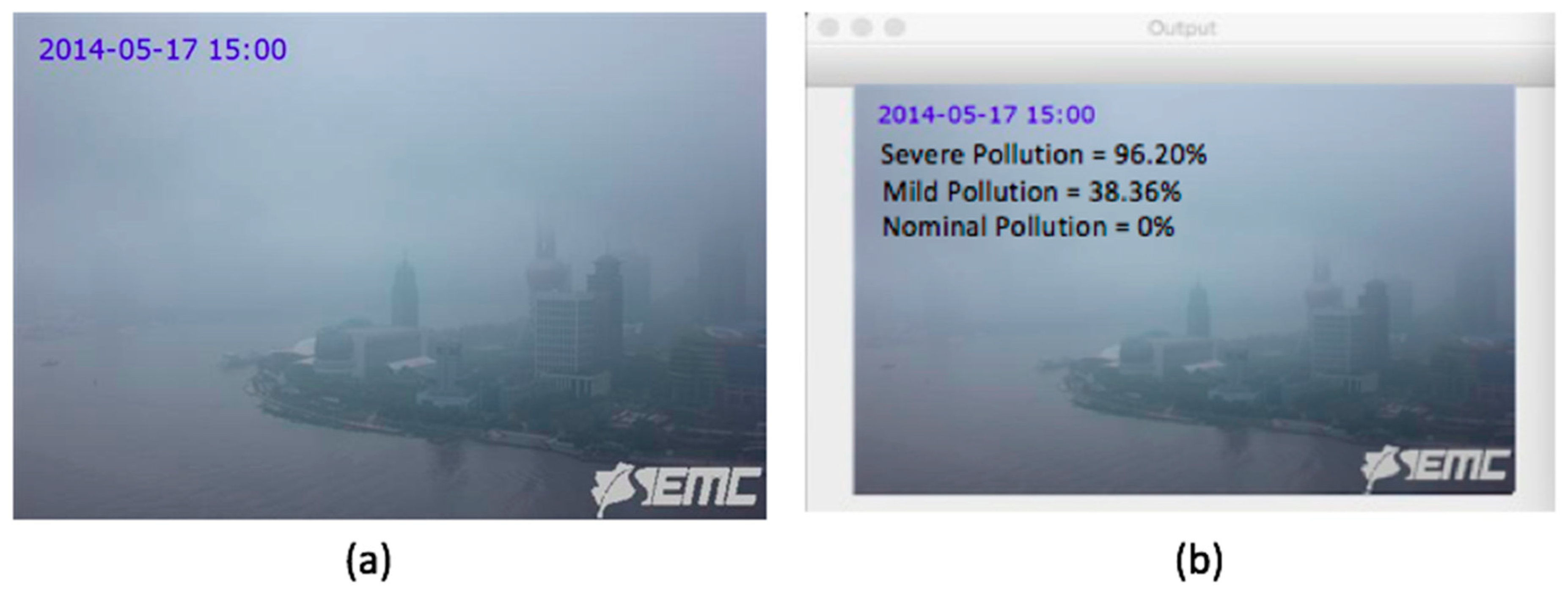
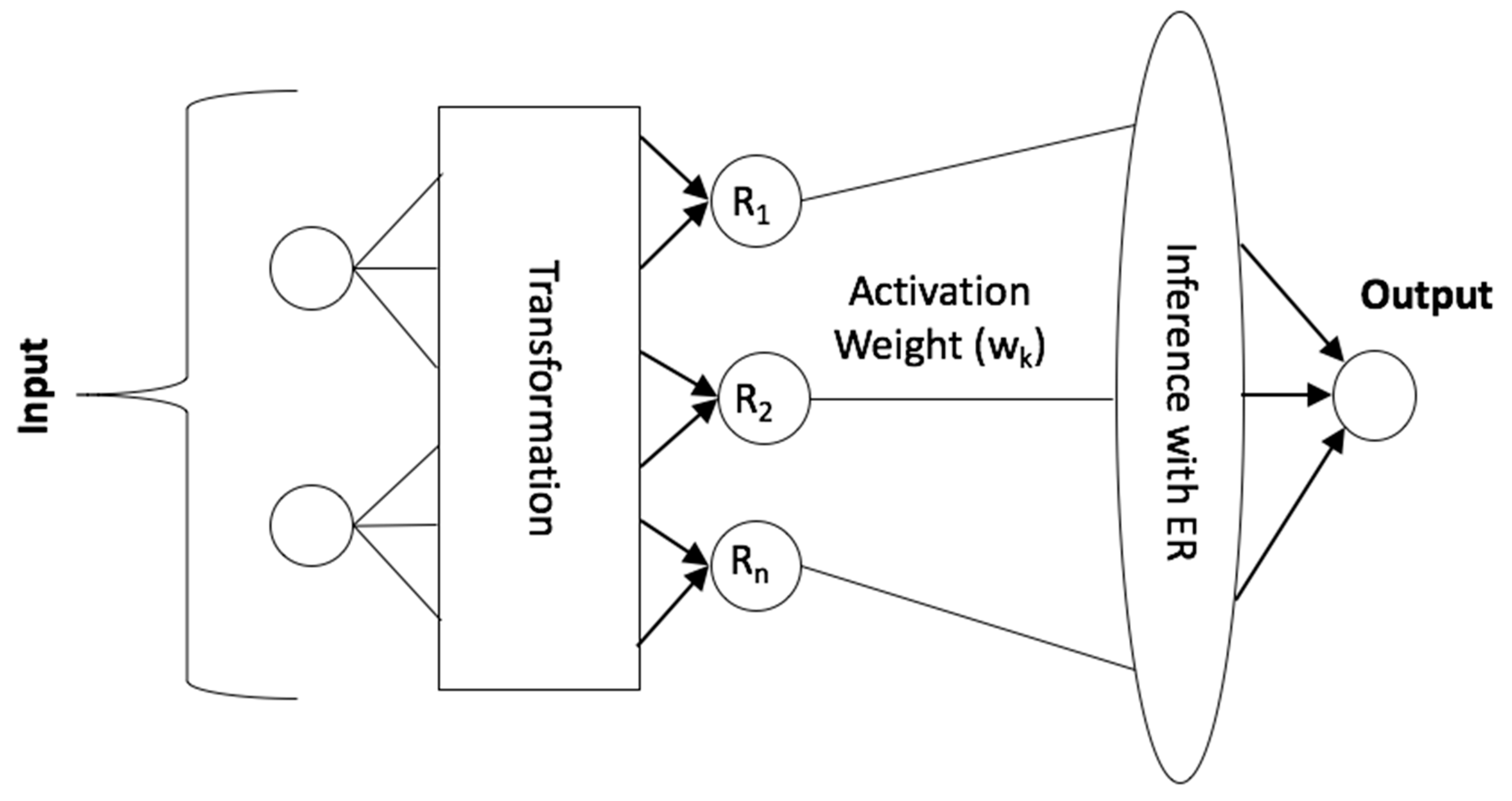
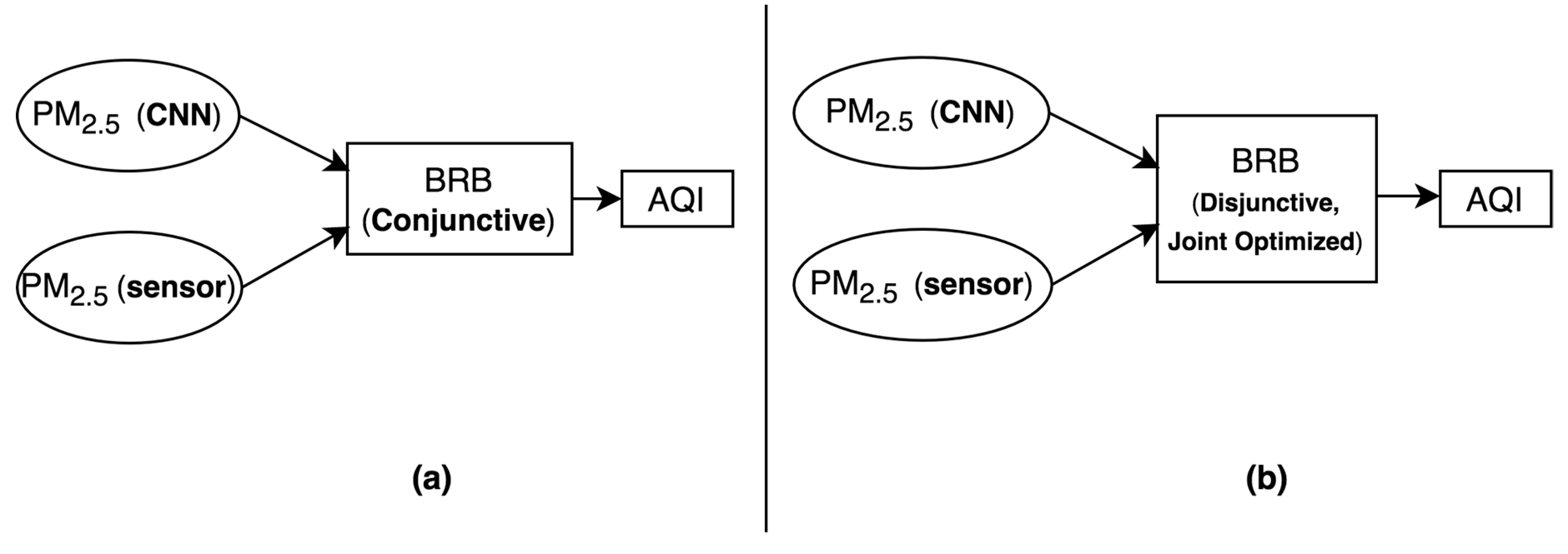


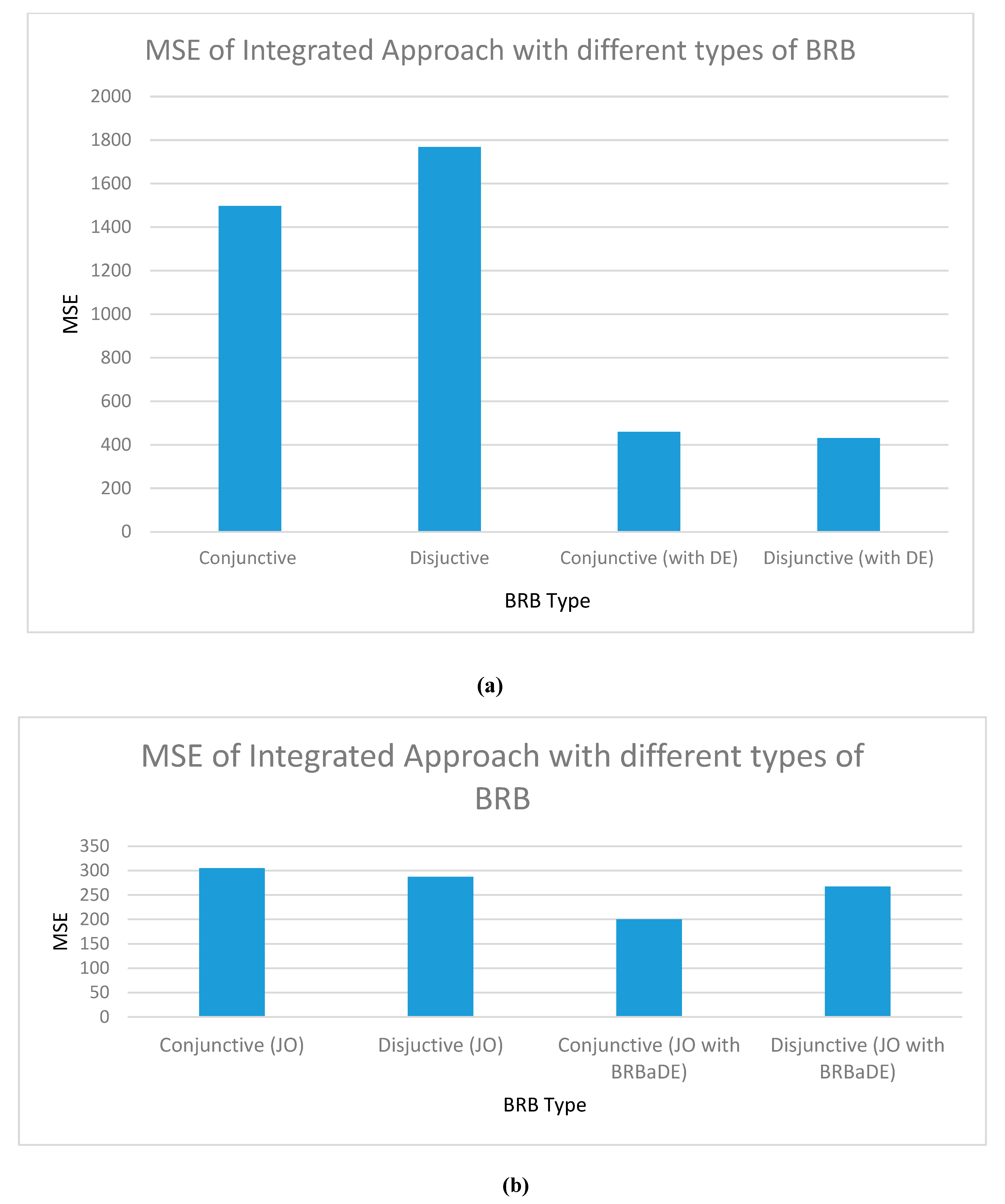
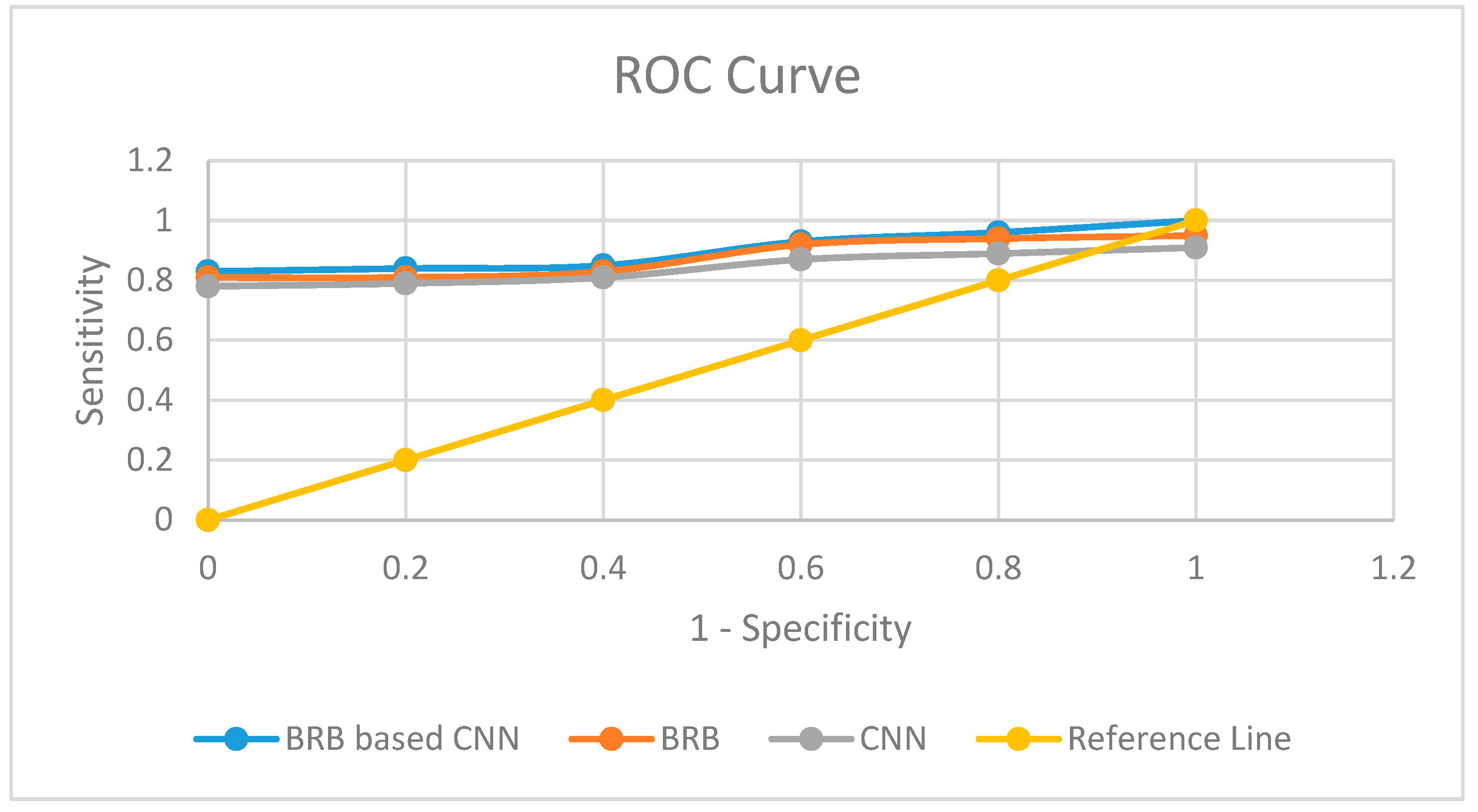
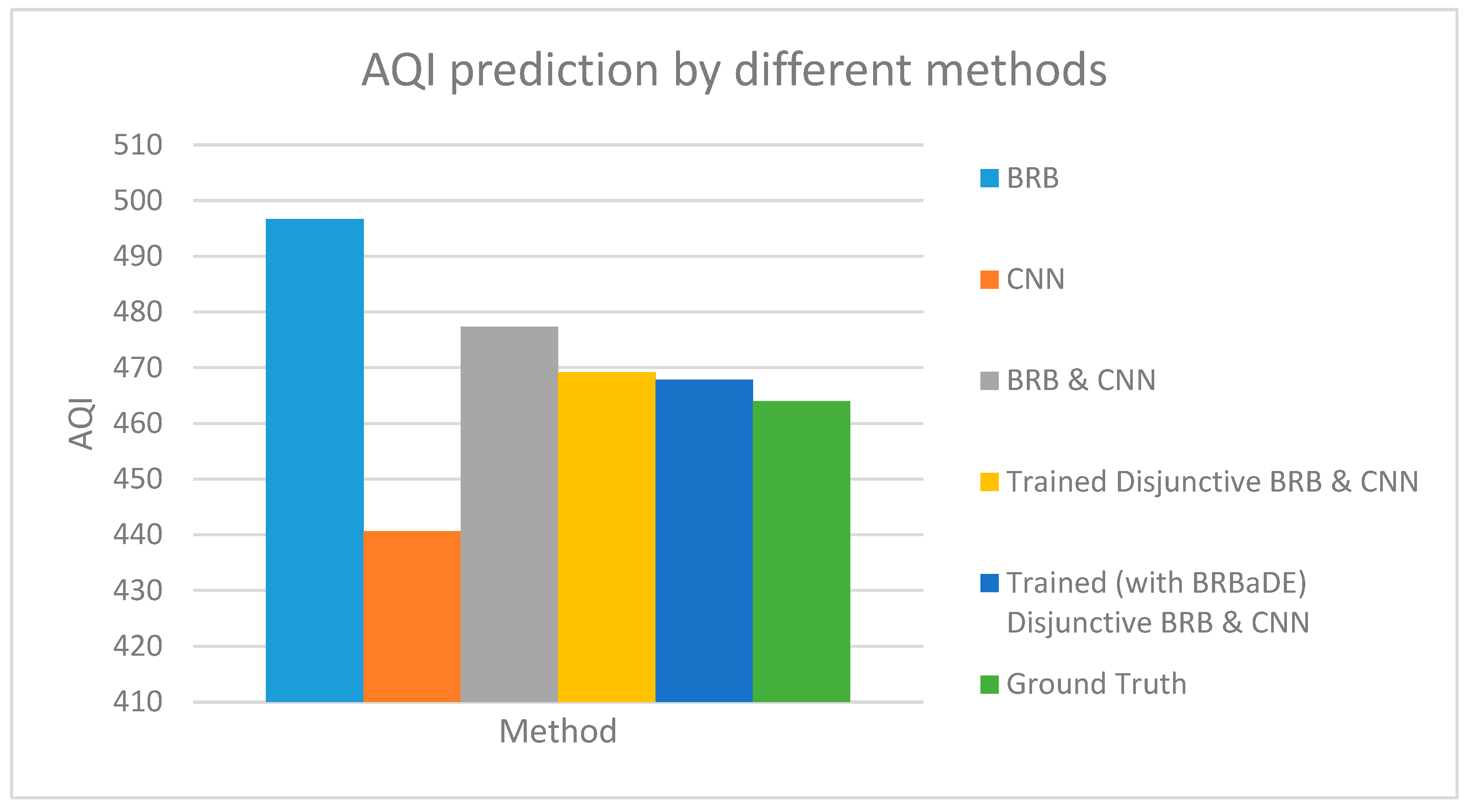
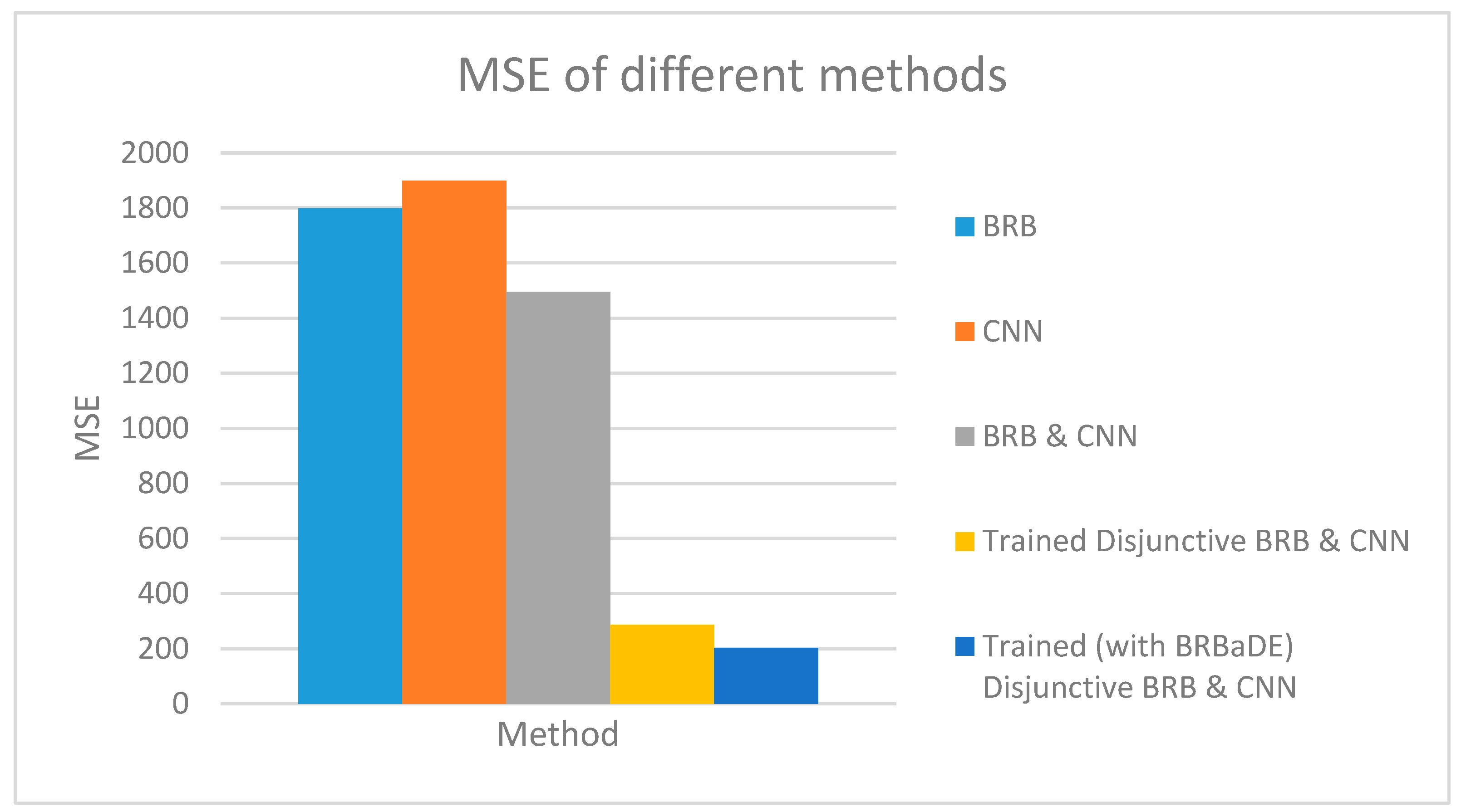
| Article | Specification | Method | Limitation |
|---|---|---|---|
| [26] | This prediction model predicts time-series concentrations of PM2.5 in Japan. In addition to time, it considers physical position of sensors to improve prediction accuracy. | Deep Recurrent Neural Network (DRNN) | This model applies Deep Learning on sensor data. However, it does not consider uncertainties associated with such sensor data. |
| [27] | This system predicts PM2.5 level based on available PM2.5 sensor data. It considers interrelationship between space and time concerning the sensor reading. | Spatiotemporal deep learning (STDL) | This system applies deep learning architecture to learn spatiotemporal features of sensor data. However, it does not deal with uncertainties of sensor data. |
| [28] | This method predicts the level of SO2, CO and PM10 of a Turkish district. It’s distance-based geographic model offers higher accuracy than non-geographic model. | Geographic Forecasting Models using Neural Networks (GFM_NN) | This method considers sensor data of neighboring district as well as distance between neighboring and target district to improve prediction accuracy. Still, it does not address sensor data uncertainties, which are likely to hamper prediction accuracy. |
| [29] | It is an image-based method to evaluate haze level of images. It has combined transmission matrix and depth map of images and demonstrated its higher accuracy on PM2.5 dataset. | Combined application of Dark Channel Prior (DCP) and Deep Convolutional Neural Fields (DCNF) | This method has demonstrated higher accuracy than separate application of transmission matrix and depth map. However, the uncertainty associated with image data is left unaddressed. |
| [30] | This paper presents a regression model to predict PM2.5 level from images of Beijing, Shanghai and Phoenix. It has considered various image features as part of this process. | Support Vector Regression (SVR) | Consideration of various image features has made this model quite representative. Even though, uncertainty handling of captured images is disregarded. |
| [31] | This paper proposes a haze image dataset with weather information. It presents an image based technique to evaluate the haze images. | Image Quality Assessment (IQA) | This IQA technique can properly assess the haze level of images. However, it disregards the uncertainties of images taken by camera sensor. |
| Model Content | Details |
|---|---|
| Input image size | 640 × 480 × 3, 584 × 389 × 3 |
| First Convolution Layer | 32 filters of size 3 × 3, ReLU, |
| First Max Pooling Layer | Pooling Size 3 × 3 |
| Second Convolution Layer | 64 filters of size 3 × 3, ReLU |
| Second Max Pooling Layer | Pooling size 2 × 2 |
| Third Convolution Layer | 64 filters of size 3 × 3, ReLU |
| Third Max Pooling Layer | Pooling size 2 × 2 |
| Fourth Convolution Layer | 128 filters of size 3 × 3, ReLU |
| Fourth Max Pooling Layer | Pooling size 2 × 2 |
| Fifth Convolution Layer | 128 filters of size 3 × 3, ReLU |
| Fifth Max Pooling Layer | Pooling size 2 × 2 |
| Fully Connected Layer | 1024 nodes, ReLU |
| Dropout Layer | excludes 50% neurons randomly |
| Output Layer | 3 nodes for 3 classes, SoftMax |
| Optimization Function | Adam optimization algorithm |
| Learning Rate | 0.001 |
| Loss Function | Binary Cross Entropy |
| Rule Id | Rule Weight | IF | THEN | Activation Weight | |||
|---|---|---|---|---|---|---|---|
| PM2.5 (Sensor) | PM2.5 (CNN) | AQI | |||||
| Hazardous | Unhealthy | Good | |||||
| R1 | 1.0 | H | H | 1.00 | 0.00 | 0.00 | 0.58 |
| R2 | 1.0 | H | M | 0.60 | 0.40 | 0.00 | 0.25 |
| R3 | 1.0 | H | L | 0.60 | 0.20 | 0.20 | 0.00 |
| R4 | 1.0 | M | H | 0.40 | 0.60 | 0.00 | 0.12 |
| R5 | 1.0 | M | M | 0.00 | 1.00 | 0.00 | 0.05 |
| R6 | 1.0 | M | L | 0.00 | 0.60 | 0.40 | 0.00 |
| R7 | 1.0 | L | H | 0.20 | 0.20 | 0.60 | 0.00 |
| R8 | 1.0 | L | M | 0.00 | 0.40 | 0.60 | 0.00 |
| R9 | 1.0 | L | L | 0.00 | 0.00 | 1.00 | 0.00 |
| Rule Id | Rule Weight | IF | THEN | |||
|---|---|---|---|---|---|---|
| PM2.5 (Sensor) | PM2.5 (CNN) | AQI | ||||
| Hazardous | Unhealthy | Good | ||||
| R1 | 1.0 | H | H | 1.00 | 0.00 | 0.00 |
| R2 | 1.0 | M | M | 0.00 | 1.00 | 0.00 |
| R3 | 1.0 | L | L | 0.00 | 0.00 | 1.00 |
| PM2.5 (µg/m3) | AQI | |||
|---|---|---|---|---|
| Sensor Data | Predicted by CNN | Predicted by only BRB (only Sensor Data Are Considered) | predicted By Integrated Approach (BRB and CNN) | Actual Value |
| 447 | 440.64 | 496.70 | 477.32 | 464 |
| 126 (wrong reading, accurate is 447) | 440.64 | 208.34 | 263.96 | |
| 4 | 2.50 | 9.17 | 14.02 | 17 |
| 243 (wrong reading, accurate is 4) | 2.50 | 259.48 | 159.53 | |
| Model | Sensitivity (%) | Specificity (%) | AUC |
|---|---|---|---|
| BRB based CNN | 94.07 | 95.61 | 0.936 |
| BRB | 92.34 | 93.61 | 0.905 |
| CNN | 89.73 | 90.74 | 0.893 |
© 2020 by the authors. Licensee MDPI, Basel, Switzerland. This article is an open access article distributed under the terms and conditions of the Creative Commons Attribution (CC BY) license (http://creativecommons.org/licenses/by/4.0/).
Share and Cite
Kabir, S.; Islam, R.U.; Hossain, M.S.; Andersson, K. An Integrated Approach of Belief Rule Base and Deep Learning to Predict Air Pollution. Sensors 2020, 20, 1956. https://doi.org/10.3390/s20071956
Kabir S, Islam RU, Hossain MS, Andersson K. An Integrated Approach of Belief Rule Base and Deep Learning to Predict Air Pollution. Sensors. 2020; 20(7):1956. https://doi.org/10.3390/s20071956
Chicago/Turabian StyleKabir, Sami, Raihan Ul Islam, Mohammad Shahadat Hossain, and Karl Andersson. 2020. "An Integrated Approach of Belief Rule Base and Deep Learning to Predict Air Pollution" Sensors 20, no. 7: 1956. https://doi.org/10.3390/s20071956
APA StyleKabir, S., Islam, R. U., Hossain, M. S., & Andersson, K. (2020). An Integrated Approach of Belief Rule Base and Deep Learning to Predict Air Pollution. Sensors, 20(7), 1956. https://doi.org/10.3390/s20071956







